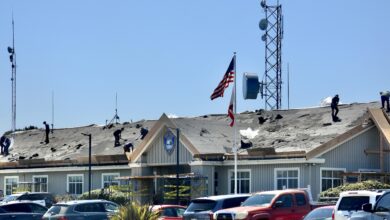Supes ask Navy for delay, congressional hearings on coast
Mendocino County Supervisors voted 4-1 on Tuesday to ask the U.S. Navy to again postpone its final deadline for public comment and to hold congressional hearings on the West Coast about plans to expand its training and testing off Northern California, Oregon and Washington.
Meeting at Fort Bragg Town Hall, the supervisors heard from about a dozen locals opposed to the expanded Northwest Range Complex Training Area.
Char Flum, vice chair of the Ocean Protection Coalition, said she had been writing letters to the Navy for four years and that strategy wasn”t enough.
“I”d like to ask these people sitting in front of us to take more definitive action against the Navy … the Navy can be sued … I”m asking the supervisors to do more than send letters,” said Flum.
The Navy formally granted extensions and delays to its process several times over the past three years, to accommodate separate delay requests made in Oregon and Mendocino County. The final environmental impact statement, initially promised to be concluded in late 2009, finally arrived on Sept. 10, beginning a 30-day public comment period, which ends Oct. 12.
Supervisors” discussion
As in 2009, Supervisor John Pinches was again the dissenting supervisor, saying military training was too important a national function to oppose.
He recalled the sacrifices made by veterans in his family and his own service as a stateside drill sergeant at the end of the Vietnam era.
“If we can”t train our military off our waters, are we going to send them to the waters off North Korea to be trained?” Pinches said.
“This has been a training area since World War II, why is this such a big issue now?”
While Pinches stuck to his original position, the tension in the room was between Chairwoman Carre Brown and the other supervisors who voted yes. Brown said “coastal supervisors” had not put the issue on the radar until the last minute and that staff didn”t have time to draft the letter.
Supervisor John McCowen interceded, offering to help write the letter and “to drive to Potter Valley” for the chair”s signature if that helped.
McGowan said he agreed with Pinches that testing is needed.
“But I”m not persuaded Navy has taken seriously any of the concerns that have been expressed. They are not properly proposing mitigation,” McCowen said.
Mendocino County has been among the most vocal areas of the Pacific Northwest about the plan, despite the fact activities are concentrated around Seattle. In fact, the training range ends at the Humboldt-Mendocino County line. The final environmental impact statement clearly states that no part of Mendocino County is included in the final plan.
Locals first got involved when it was unclear where the southern boundary was, in the preliminary environmental impact statement. The Navy even came to Mendocino County to explain the program, at the request of Congressman Mike Thompson, who had initially attacked the Navy for poor communication about the training range.
Heidi Dickerson, representing Thompson, explained to the crowd that the Navy had responded to criticisms, including removing bombs that contain depleted uranium from the weaponry to be utilized in the area. She said the Navy has taken numerous measures to avoid marine mammals.
Testing area
The testing area includes 122,400 nautical miles of air, land (all the way to Idaho), the Pacific Ocean 288 miles out, and subsurface space for underwater weapons training exercises. No training that involves live explosives is conducted within 3 nautical miles of shore, the final environmental impact statement promises.
“Historically, as well as projected for the next five to ten years, training within 12 nautical miles seldom, if ever, occurs off the coast of Oregon and Northern California,” the final document states.
While the area can still be used for testing, the increased activities documented in the statement concern training.
The Navy”s preferred alternative would increase missile firing during exercises from 10 fired per year to 57, while bomb dropping would increase from 108 to 144 per year. The Navy would increase the number of shells it fires, from 25,856 per year to 53,343.
With the last public meeting having been held 20 months ago, the late and voluminous final environmental impact statement is available for download at www.nwtrangecomplexeis.com and in paper form at the Eureka library.
Comments can also be mailed attention Kimberly Kler, Naval Facilities Engineering Command Northwest, 1101 Tautog Circle, Suite 203, Silverdale, WA 98315-1101.




